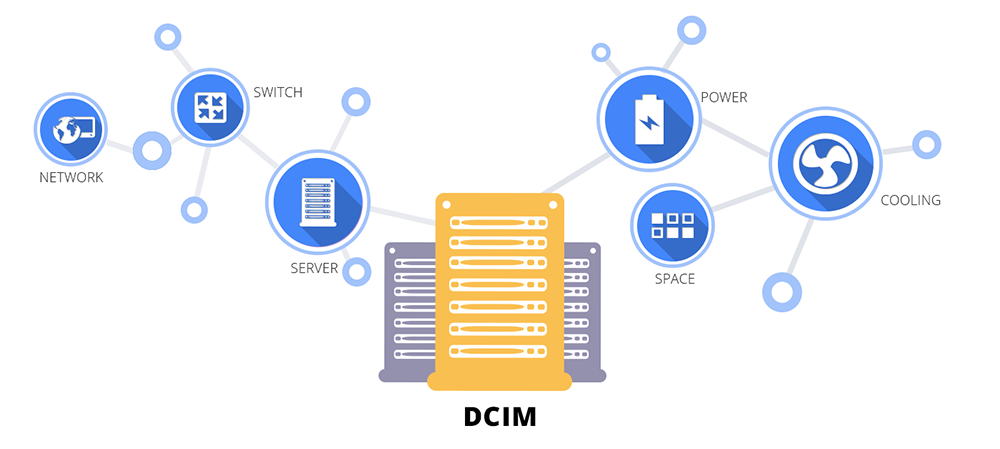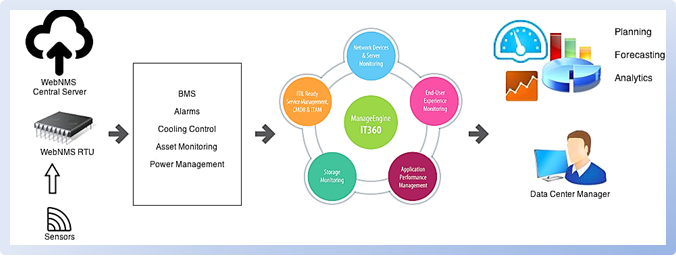Today’s data centers are not just a location that houses storage systems; they enable competitive advantage and are intertwined to corporate success. The emergence of new deployment models such as cloud, hosting, colocation and virtualization in recent years have placed additional pressures on infrastructure management. The current explosion in cloud computing is driving the demand for data centers and is expected to grow at a CAGR of 10%. As the growing number of data centers witness expansion in terms of capacity, they are also faced with spiraling operating costs.
The performance of data centers are linked to business success hence data center managers have been challenged to deliver availability, capacity, and efficiency in the face of escalating demands. The growing facilities infrastructure not only amplifies costs and carbon footprint but also puts business at risk.
Data centers now need to be profitable to meet regulatory requirements and deliver business demands. This increases the importance of real-time holistic management capabilities, visibility of IT and facilities infrastructures. An effective data center infrastructure management strategy will increase the efficiency, utilization, and availability of all data center assets and services.
Bridging DCIM Gap
DCIM encompasses the IT infrastructure layer (servers, network switches, routers, LAN, WAN and storage arrays) and the data center facilities layer (power, temperature, humidity, inventory, battery, security) that enables the IT realm to function. Monitoring and managing IT assets alone will not tackle vital issues of operational performances like cooling utilization, battery health, PUE and security. Further, IT management solutions generally fail to provide alarm management capabilities and central visibility of asset utilization.
Unified DCIM is a new perspective to manage and bridge the critical infrastructure gap through:
- Proactive approach provides real-time information to swiftly react to potential issues
- Holistic management of IT and facilities infrastructure
- Remote Monitoring eliminates failures, prevents data loss and increases uptime
- Remote diagnostics and troubleshooting enables data center personnel to quickly respond and control changes in infrastructure facilities
- Resource Utilization – resources are optimized in line with business needs
- Analytics provides actionable insight on the passive assets utilization
Streamline and Simplify through an Integrated DCIM
Increasing the number of devices requires more floor space, more power and hence spiraling costs. Although a DCIM solution simplifies the management of data centers, its value can be realized only when an integrated DCIM is in place. Organizations have to break free from the silos that exist within the data center by involving performance management, asset utilization, reporting and analytics. Data centers can leverage infrastructure management by monitoring and controlling tens of thousands of heterogeneous passive assets stretched across multiple locations and geographies.
Comprehensive visibility and management of data center facilities is attained by integrating various sensors and system feeds that collect data from the assets which are fed into the process to derive information and then the information is presented to data center managers in the form of a dashboard.
- Power Management notifies critical electrical network problems and monitors energy consumption
- Asset Management maximizes returns on investment by proactively managing assets to extend their life
- Alarm management detects fluid leaks, smoke and triggers alarm
- Security provides identification and tracking of human activity in and around the data center
- Sensors placed within the physical space collect, orchestrate and evaluate data across the data center. For instance, temperature sensors that prevent overheating and ensure optimal temperature is maintained reducing cooling costs. Vibration sensors prevent malicious or accidental tampering of racks.
WebNMS M2M as DCIM
To address the DCIM gap and operational challenges WebNMS DCIM presents a web-based centralized solution for comprehensive management of the entire data center infrastructure, including IT and non-IT assets. WebNMS DCIM is a convergence of the WebNMS M2M framework and the ManageEngine Integrated IT management solution, IT360.
WebNMS M2M architecture comprises of RTU as hardware and central monitoring software. The RTU (Remote Terminal Unit) collects data from devices and communicates to a central management system via Ethernet/GPRS/Satellite.
WebNMS can monitor tens of thousands of devices located in remote sites and can serve dozens of NMS users remote sites managed from a central Network Operations Centre (NOC). It enables operators to understand, anticipate and respond to real-time information from the remote sites thus making more-efficient, cost-effective and greener environments.
The unified dashboard provides accurate real-time visibility into facilities infrastructure from a single console. For instance, the dashboard below shows power consumption trends, sensor status, temperature and recent alarms:
Managing the critical infrastructure ensures that data center managers focus on strategic IT issues. WebNMS DCIM offers centralized management of infrastructure facilities that cuts data center costs and complexity and increases capacity and uptime.
For more information, please visit www.webnms.com/m2m
DEMO: http://www.webnms.com/m2m/demo-request-form.html?demo=dcim

